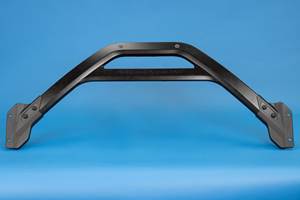How do we integrate composites into the auto supply chain?
I am attending this week (Sept. 7-9) the Society of Plastics Engineers’ (SPE) Automotive Composites Conference and Exhibition (ACCE) in the Detroit suburb of Novi, MI, US.
I am attending this week (Sept. 7-9) the Society of Plastics Engineers’ (SPE) Automotive Composites Conference and Exhibition (ACCE) in the Detroit suburb of Novi, MI, US. The first time I attended this event, in 2007, there were — maybe — 300 people in attendance. By 2009, with the Great Recession in full swing, it seemed like those who gathered at ACCE were glad to be producing vehicles at all, much less ones that incorporated composites. By 2012, conference participants were seeing some light at the end of the automotive tunnel, and it was not unreasonable to think that composites had a future in automotive, particularly given new and aggressive corporate average fuel economy (CAFE) standards.
Today, ACCE is, without doubt, the largest automotive composites event in the world, attracting more than 900 people and 75 exhibitors, and featuring more than 90 technical paper presentations. And all of us, including me, are here learning about new bonding technologies, sheet molding compound innovation, fiber reinforcement draping simulation ... and much more.
The people here represent the entire automotive supply chain, ranging from resin suppliers to composites fabricators to (yes!) OEMs — 130 or so, from what I hear. They represent some of the best automotive engineering minds the world has to offer, and they ask excellent questions of highly qualified, thoroughly vetted speakers who present well-researched papers.
There is one question, however, that seems to generate a different answer for each person to whom I put it. The question is this: If the growth of ACCE is symptomatic of the overall growth of composites in automotive, then all those really great composite parts that result must be integrated into the automotive supply chain. How is that going to work?
I ask this question for two reasons: First, the automotive supply chain is a world unto itself, full of rules, traditions and expectations found nowhere else in the manufacturing world. Second, except for a very small handful of companies, there are none in the composites world that have experience serving that supply chain. And although this handful of companies might be able to serve a few customers’ needs, they alone cannot serve the entire industry.
So, if, in fact, automotive OEMs not named BMW are serious about using composites in quantities that — to us — might represent the next Great Composites Expansion, who is going to do the actual work required to make it happen? Where will the technical brain-power and manpower come from? Who can provide parts in the quantities the auto industry requires? Which processes will be used? How will all this be integrated into the automotive supply chain?
I used to think that the automotive Tier 1 suppliers would be handed the job, but aside from activity at companies such as Magna, Continental Structural Plastics and Faurecia, it’s difficult to tell how much legwork Tier 1s are doing. That leaves a few possibilities, as far as I can see.
First, maybe it’s too much to expect that one type of supplier can meet the automotive industry’s composites needs. Perhaps a cooperative venture is required, involving resin suppliers, fiber suppliers, fabricators and Tier 1s. There is some evidence to support this, particularly on the materials side, where resin and fiber suppliers already supply technical know-how to a variety of automotive OEMs.
Second, perhaps we are on the verge of the emergence of a disruptive technology — like, for example, liquid compression molding — that will make composites unbelievably attractive to automotive OEMs. Or, perhaps Google or Apple are developing disruptive vehicles that will transform how we think about transportation, and manufacturing for transportation.
Third, we might be on the cusp of a Pretty Good Composites Expansion, one in which we’ll see composites consumed in moderate volumes and only in mid-level to high-end cars. Not the end of the world, but definitely lacking the satisfaction of that full-blown Great Composites Expansion.
So, there you have it — three speculative answers to one question from one person. I’m all ears if you have your own ideas about what the future might hold. E-mail me at jeff@compositesworld.com.
Related Content
Infinite Composites: Type V tanks for space, hydrogen, automotive and more
After a decade of proving its linerless, weight-saving composite tanks with NASA and more than 30 aerospace companies, this CryoSphere pioneer is scaling for growth in commercial space and sustainable transportation on Earth.
Read MoreCo-molding SMC with braided glass fiber demonstrates truck bed potential
Prepreg co-molding compound by IDI Composites International and A&P Technology enables new geometries and levels of strength and resiliency for automotive, mobility.
Read MoreAutomotive chassis components lighten up with composites
Composite and hybrid components reduce mass, increase functionality on electric and conventional passenger vehicles.
Read MorePlant tour: Joby Aviation, Marina, Calif., U.S.
As the advanced air mobility market begins to take shape, market leader Joby Aviation works to industrialize composites manufacturing for its first-generation, composites-intensive, all-electric air taxi.
Read MoreRead Next
Developing bonded composite repair for ships, offshore units
Bureau Veritas and industry partners issue guidelines and pave the way for certification via StrengthBond Offshore project.
Read MoreVIDEO: High-volume processing for fiberglass components
Cannon Ergos, a company specializing in high-ton presses and equipment for composites fabrication and plastics processing, displayed automotive and industrial components at CAMX 2024.
Read MorePlant tour: Daher Shap’in TechCenter and composites production plant, Saint-Aignan-de-Grandlieu, France
Co-located R&D and production advance OOA thermosets, thermoplastics, welding, recycling and digital technologies for faster processing and certification of lighter, more sustainable composites.
Read More



















